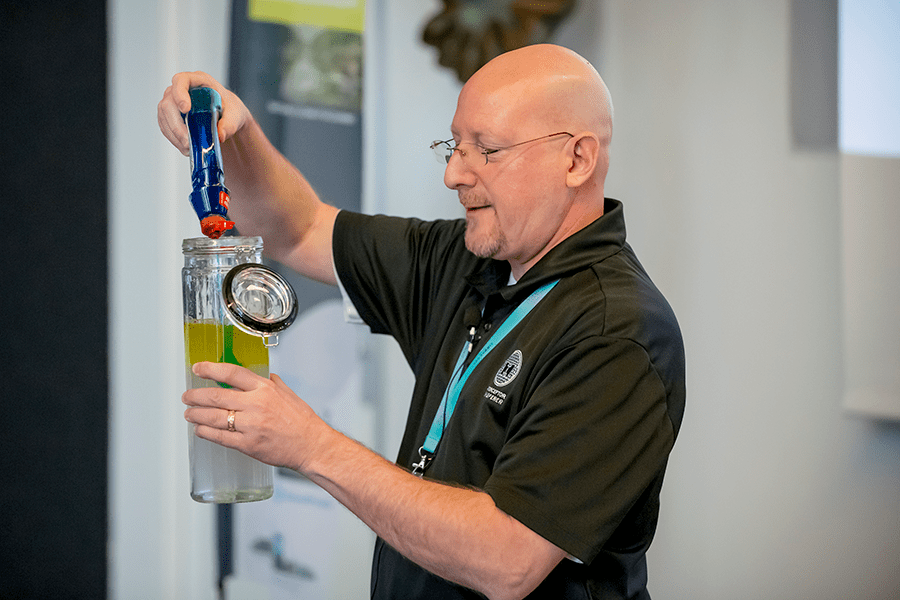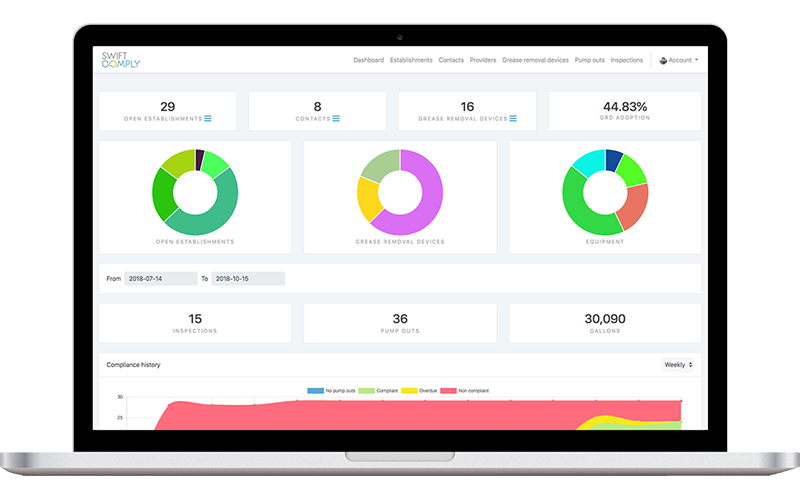Last month the SwiftComply team headed out to Hood River, Oregon with three of our newest teammates in tow. Our destination the 2019 Western States Alliance FOG Forum for 101 crash course on all things FOG. Throughout the forum, we met quite a few city regulators who had recently been tasked with starting a new FOG program. Just like us, they were there to learn everything they could about FOG program management. We all came away with a better understanding of the challenges faced by city regulators and service providers, plus best practices on how to meet those challenges and keep FOG out of our cities’ sewers. Here are some highlights:
City of Seattle – How to build a successful FOG program
Kicking off day one, Angelique Hockett from the city of Seattle gave an overview of the Seattle Public Utilities (SPU) FOG program. With 750,000 residents and 5,500 foodservice establishments in their jurisdiction, it’s a big task to regulate FOG disposal.
Angelique laid out a three-fold approach that focuses on (1) which establishments to inspect, (2) how to inspect them efficiently, and (3) explaining why they’re being inspected.
Seattle Public Utilities prioritizes establishments into 6 categories determined by their proximity to FOG “hotspots”. These hotspots are based on FOG buildup in the sewers they are connected to and previous FOG-related blockage incidents. Once SPU knows which establishments they need to prioritize for inspections, the inspections focus on making sure:
1. The establishment’s grease trap is properly sized and installed
2. All FOG-producing drains are connected to the grease control device
3. The establishment is maintaining its interceptor log
Before and after inspections, SPU educates Food Services Establishments with a “Path to Success”. This builds community and creates a shared understanding of the goal of keeping our sewers clear and rivers clean.
This presentation resonated with FOG program managers from all size jurisdictions provided the attendees with building blocks for paths to success in their own cities.
The Interceptor Whisperer – The science of grease interceptors
Next up was Ken Loucks from IW Consulting Services with presentations full of facts for both FOG newcomers and experienced professionals. Ken gave a history lesson on the evolution of grease interceptors on day one and explained how they actually work on day two, with a live demonstration of gravity-differential separation.
We got to see all the advancements that have been made in this technology and get a better understanding of why grease interceptors work from a physics standpoint. It turns out hot water doesn’t HAVE to be your enemy if a properly sized grease interceptor is installed. For the SwiftComply team and FOG program managers alike, knowing exactly how interceptors operate really helps us understand the day to day challenges experienced by the foodservice establishments and service providers that we work with.
Check out his blog for a wealth of information.
Case studies – How SwiftComply works for your city
We were also excited to hear presentations each day from SwiftComply users in Oregon and how they use SwiftComply software to meet their daily challenges.
Paul Kramer
City of Gresham, OR
Paul provided FOG Forum attendees a via demo walkthrough of the SwiftComply inspections product. He first showed how inspectors use it to conduct, save, and email an inspection in the field. Then he explained how they sort, filter, and export this inspection data back in the office to create fast and easy reports for management. This reporting function is key for the City of Gresham, as they’ve expanded across departments and are using the software for FOG, Well Field, and Automotive Related Business Inspections.
This looks into the daily use of the platform and was a great resource for other FOG program managers who wanted to know exactly how he uses it to meet the challenges faced in Gresham.
Christina Davenport
City of Bend, Oregon
Christina closed out the day by giving an overview of how SwiftComply’s digital pump out reporting tool has affected the City of Bend’s FOG program since it’s implementation In January 2019. Their goal was to receive 80% of pump out reports directly from FSEs and service providers into their SwiftComply database in order to free up inspector’s time and let them focus on the real problem areas and new industries.
Previously, the city was receiving a monthly report of pump-outs from service providers but this information had to be manually entered into a database. Christina says that the keys to the success of the program implementation were:
- Initial service provider education and training on how to report pump-outs for their FSE customers
- Multiple rounds of program announcements to FSEs via email and letters with a call to digitally enroll and begin reporting pump outs
- In-person training and feedback sessions with Service Providers and FSE’s
She presented impressive results just 60 days into implementation:
– 8 of the city’s 10 service providers enrolled and reporting pump outs
– 50% of FSEs enrolled
– Over 1000 pump-outs reported digitally
Bend is already looking to broaden the future scope of digital tracking and include industries like brewing and high-strength waste.
If you’d like to learn more, check out our presentation on how to automate your FOG program or drop us a line at hello@swiftcomply.com.



